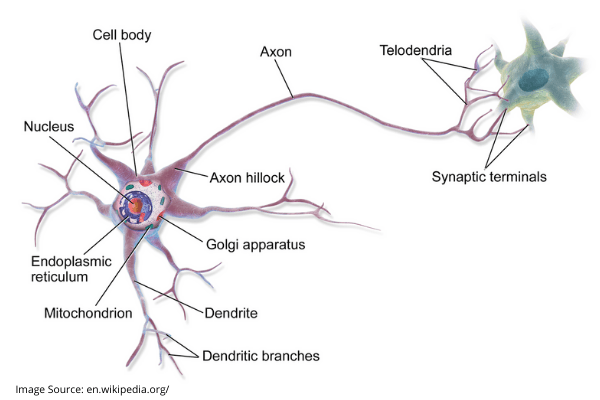Understanding Nerves and Neurons
Did you know that there are approximately 86 billion neurons in your brain! And what do they do? They’re the reason why your brain transmits information to other organs of the body. They’re connected with other neurons to allow the brain to think, act, and perform all activities. Here’s a simple guide to help you understand nerves and neurons:
What is a Neuron?
They’re cells within the nervous system; a neuron is the most basic building block of the brain. While they may seem similar to other cells in the body, there’s one primary difference- neurons transmit information within the body. This is done through chemical and electrical impulses. And unlike other body cells, they do not reproduce after birth, but create new connections. There are more than 10,000 different types of neurons, but by a general classification, you can divide them into three categories, sensory neurons, motor neurons, and interneurons.
Sensory Neurons
Sensory neurons communicate with the central nervous system by responding to touch, sight, hearing, taste, smell, etc. They send information from the skin, eyes, ears, nose, and tongue.
Motor Neurons
Motor neurons are responsible for involuntary muscle functions like the beating of the heart, passage of food, breathing, etc.
Interneurons
Interneurons are found in the central nervous system and connect the sensory and motoneurons. They send information between these neurons.
Parts of a Neuron
A neuron is made up three parts, viz. the cell body or soma, dendrites (aka signal receivers), and an axon. The cell body has a nucleus with at least one nucleolus and many cytoplasmic organelles. Dendrites are extensions that send and receive signals from other neurons. While some cells have few dendrites, other cells have highly branched dendrites to help them receive information. Axons also take information from other cells in the body. When in a bundle, they are called nerves. The longest axon in the body runs for around 3 feet- from the bottom of the spine to the toe.
Synapses, Neurotransmitters, and more
Cells when connecting with one another are called synapses. As mentioned earlier, neurons communicate using electrical impulses and chemical messengers. Once an electrical impulse reaches the end of the axon, a message is transmitted to the dendrite of an adjoining neuron. Sometimes this impulse is instantly transmitted, and sometimes, this is done through neurotransmitters. Scientists have identified around 100 such neurotransmitters, including endorphins, dopamine, and acetylcholine.
Common Neurological Disorders
Although there are more than 600 neurological ailments, the most common among them are:
Alzheimer’s Disease/Dementia and Disorders Affecting Memory Functions: These are neurodegenerative diseases that affect a person’s memory and causes problems with thinking and behavior.
Migraines: A migraine refers to an intense headache that can cause nausea, sensitivity to light, sound, or smell, etc. While scientists do not know what could trigger a migraine, some of the causes could include irregularities in the brain’s blood vessels.
Parkinson’s: Parkinson’s is a motor system disorder resulting from the loss of dopamine-producing neurons.
Keeping Your Brains Healthy: With a little effort, you can keep your mind fit and active. Learn a new language. Take up a new hobby. Eat a healthy diet. Keep a Rubik’s cube. Stay connected with family and friends.
Ten Effective Remedies That You Can Refer to When You Are Suffering from Muscle Cramps
Finally starting off with the gym life can get too overwhelming until you hit those muscle cramps along with the weights.
ICSI(Intra Cytoplasmic Sperm Injection)
Normally during every mid-menstrual period, one of the 2 ovaries releases an ovum. Each ovum is covered by a membrane called follicle,
Pregnancy and Delivery Care
Nothing could possibly compare to the joy of becoming a parent. After nine long months of waiting, the moment you have been waiting for is almost there:
Some Common Causes of Chest Pain
The first thing that jumps into the mind whenever you have some sort of chest pain is heart attack! It’s only human to feel that way
Organic Food Vs GMO Food: What Should You Pick?
There is no doubt that the quality of food we consume is crucial for our good health. And with more people becoming health conscious the d
Importance of Breastfeeding and Vaccinations for Newborns
Going nature’s way is best when it comes to providing nourishment for the apple of your eye – your baby. Breast milk is best for your baby as it
Percutaneous Nephrolithotomy (PCNL): A Breakthrough in Kidney Stone Treatment
Kidney stones, those small, hard mineral deposits that form in the kidneys, can cause excruciating pain and discomfort.
Skin Tags - Benign Tumor or Cancerous Tumor?
Skin tag if observed is a narrow stalk that hangs about your skin, bulging at the end. They are usually freshly colored and can grow anywhere on your body.
3 Ways Vitamin C is Helpful for the Immune System
The water-soluble vitamin, Vitamin C is also known as ascorbic acid. It is helpful in building up the blood vessels, skins, and making bones stronger
4 Signs of Mental Illness
As life has gotten fast and hectic, different health issues have got introduced lately. Not just physical issues,
4 Ways Night-Shifts Can Be Dangerous For Your Menstruation And Ovulation
A good night's sleep is of value for pregnant women. But with strenuous work-hours and shift work, sleep can quite a luxury for all.
Causes Of Infertility in Women
More and more women are putting off pregnancy till well into their 30’s or early 40’s for career reasons; infertility is fast becoming a major heartbreaking issue for such couples.
Do Not Indulge in These 9 Common Dieting Mistakes
Dieting is not just about eating less or starving yourself to meet unrealistic goals. Healthy dieting involves making informed food choices.
Laryngeal Reiinervation Procedure at KIMS Hospital
Mr. K.P 56-year-old business executive from Bangalore underwent a thyroid surgery two years back.
Learn How Stress Affects Your Heart Health
Stress is a frequent side effect of the modern 21st Century lifestyle. We’re always running around to meet deadlines, pay bills we tend to
Lose Weight: The Healthy Way
Almost everyone we know is worried about the way they look. There are several concerns people have, like their complexion
Myths About Bariatric Surgery
Bariatric surgery – be it the gastric bypass and other weight-loss surgeries – involve making changes to your digestive system to help you lose weight.
Non-alcoholic Fatty Liver Disease: Should You be Worried?
A recent study has found that 1 in 5 people in India suffers from liver disorders. Before you blame it on the increased alcohol consumption
Obesity and its Relation to Type 2 Diabetes
Diabetes is a condition that arises when the body doesn’t produce enough insulin,, hence there is excess glucose in the blood
Rotator Cuff Tear
A rotator cuff tear is a rotator cuff injury that can cause shoulder pain and loss of arm function. The rotator cuff is a set of muscles and tendons in your shoulder.
What Happens to Your Body When You Fast?
Fasting has been practised by humans for thousands of years as a way of rejuvenating the mind, body and soul and as a common ritual of many religions from all over the world
Why You Shouldn’t Consume Medicines with Cold Water
There has been a long-raging debate on the temperature of water needed for consuming medications. You won’t find much as in research papers
10 Tasty Delicious Diabetic-Friendly Recipes
Worry about it no more, as a healthy diabetic diet does not have to be bland. Instead, you can enjoy a myriad of flavorful, low-calorie
4 Not So Common Health Problems in Teenagers
The current generation of teenagers have far more access to technology and gadgets than their parents did.
4 Secrets to Adjusting Your Toddler's Sleep Cycle
Most of the parents, some time or the other, may have faced the trouble of making their toddlers sleep at night.
Related Blogs
Ten Effective Remedies That You Can Refer to When You Are Suffering from Muscle Cramps
Finally starting off with the gym life can get too overwhelming until you hit those muscle cramps along with the weights.
ICSI(Intra Cytoplasmic Sperm Injection)
Normally during every mid-menstrual period, one of the 2 ovaries releases an ovum. Each ovum is covered by a membrane called follicle,






































